“Whose Prayers Did God Hear?”
 David Smith
David Smith
“Whose prayers did God hear?” A fellow historian of Christianity posed this question to me on a hot but breezy day in Cape Coast, Ghana. We were leaning against the white-washed walls of Cape Coast Castle, a UNESCO World Heritage site, and looking across its bastions at Ghana’s first Anglican worship space.
Directly beneath that humble chapel and hub of missionary activity was the main tunnel of a dungeon that once housed hundreds of enslaved people during their final days on African soil before they were forced to make the daunting sojourn through various empires’ networks.
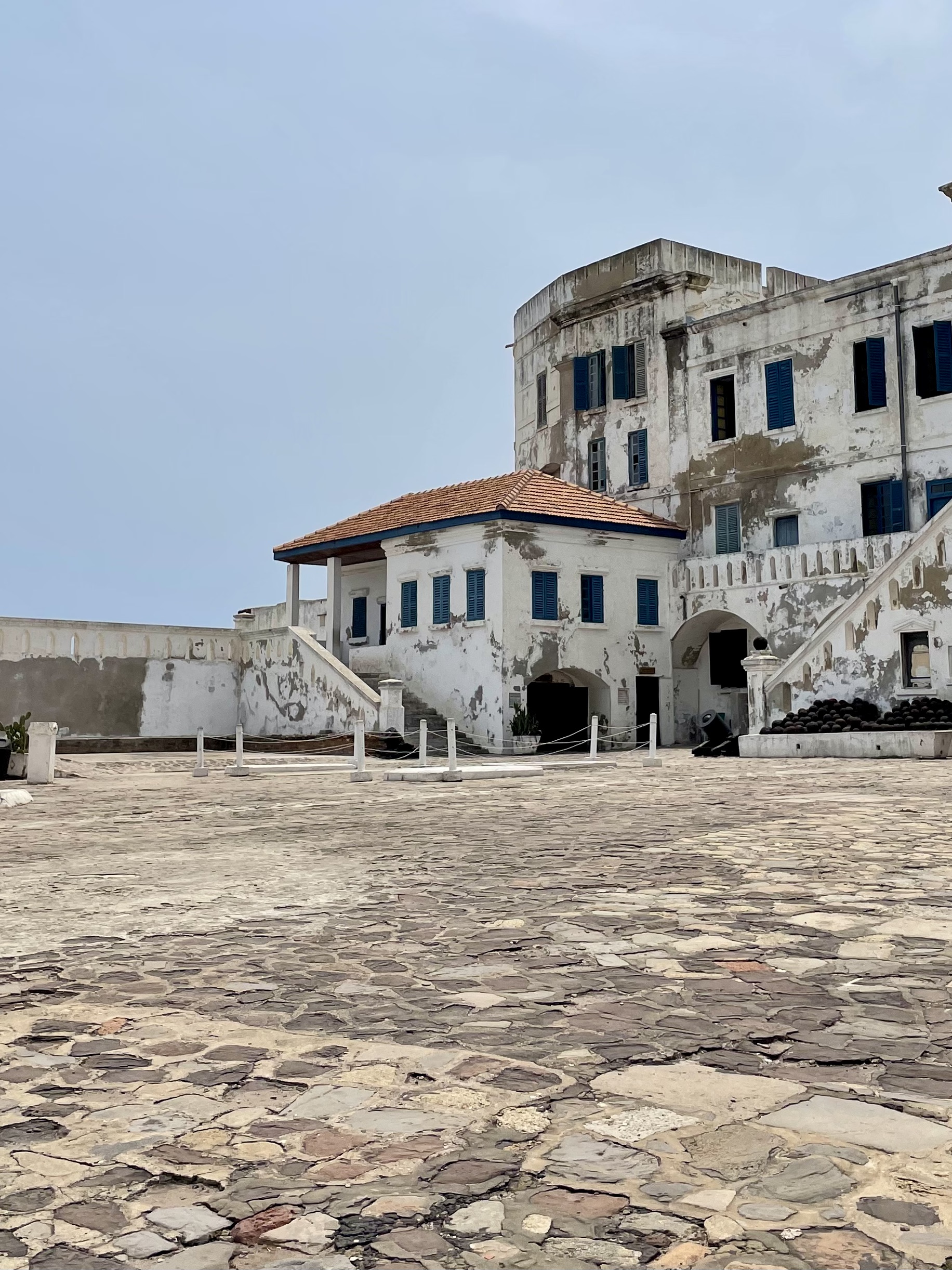
The chapel, which is integrated into the fortress, can be identified in this photo by its red roof and blue shutters. The large double door beneath the upper room is the main entrance to the ‘male slave dungeon’ (Photo by the author on 13. March 2024).
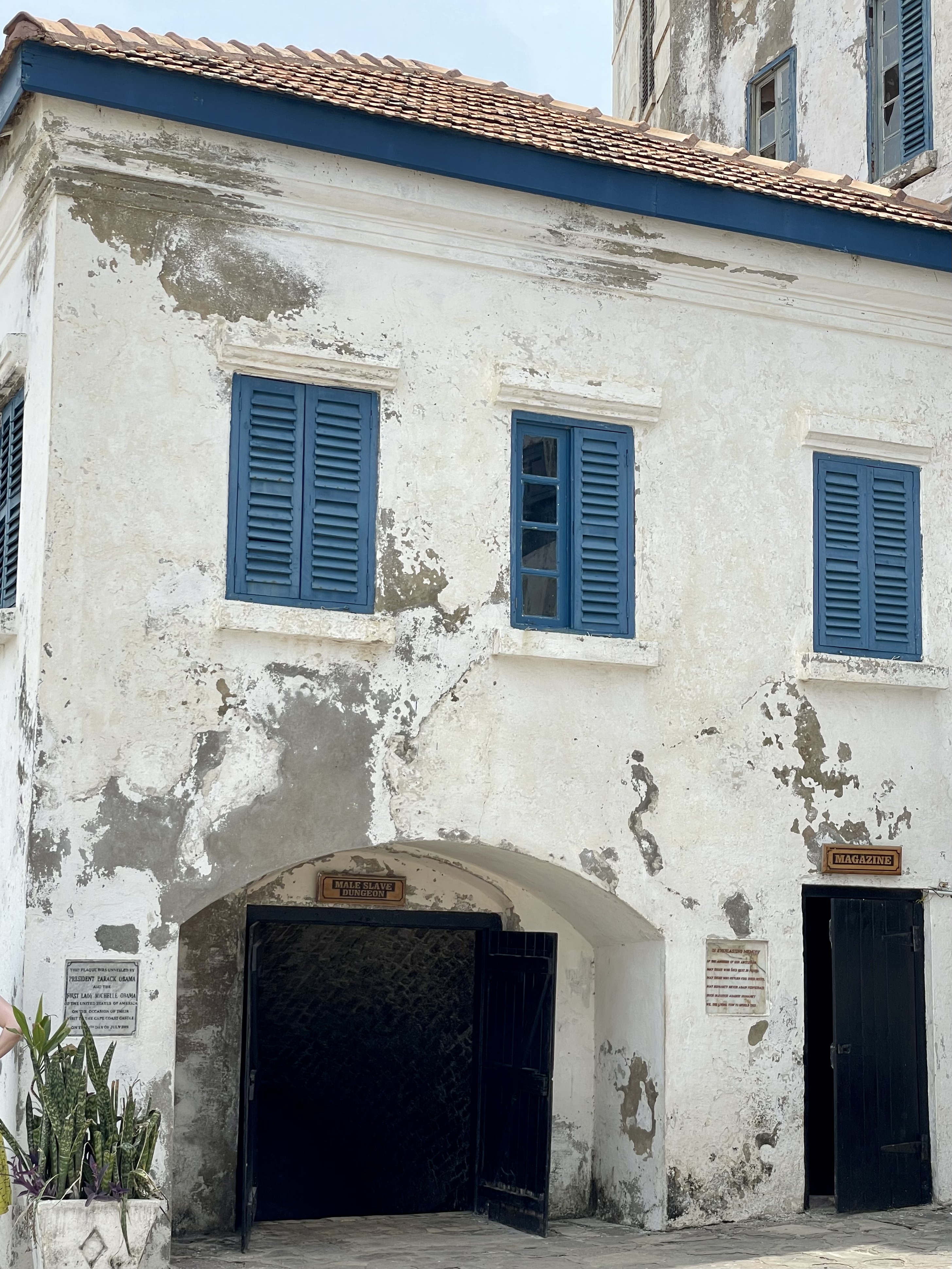
This photo of the same structure shows the main tunnel that leads to the ‘male slave dungeon’ (the dungeons were segregated by biological sex) underneath the worship space (Photo by the author on 13. March 2024).
Like other, more famous castles in the region, Cape Coast Castle has had many owners and served various purposes over the centuries. The Portuguese first established a trading post called Cabo Corso (‘short cape’) on this site in 1555. Initially, the trade was in gold and timber. Eventually, however, this location became one of many hubs for the Atlantic Slave trade.
In the centuries that followed the construction of the earliest buildings, the forts on this site were subsequently possessed by the Swedes, the Danish (that’s a complex story!), the Dutch (again, a complicated story!), and, after 1664, the British. Since Ghanaian independence in 1957, the castle has been under the care of the Republic of Ghana.
Under the leadership of the Reverend Thomas Thompson, the first Anglican missionary to Africa, the Society for the Propagation of the Gospel (SPG) arrived in Cape Coast in 1751. A mission arm of the Church of England, the SPG was tasked with caring for the spiritual needs of European settlers and converting non-Christian populations ‘in foreign parts.’ It operated out of the worship space pictured above.
In the stone-covered courtyard of the castle, just down a set of steps from the chapel and adjacent to the most direct path from the male slave dungeon to what is now called the ‘door of no return,’ the Reverend Philip Quaque (or Quacoe), the first African to be ordained in the Anglican church, lies in rest.
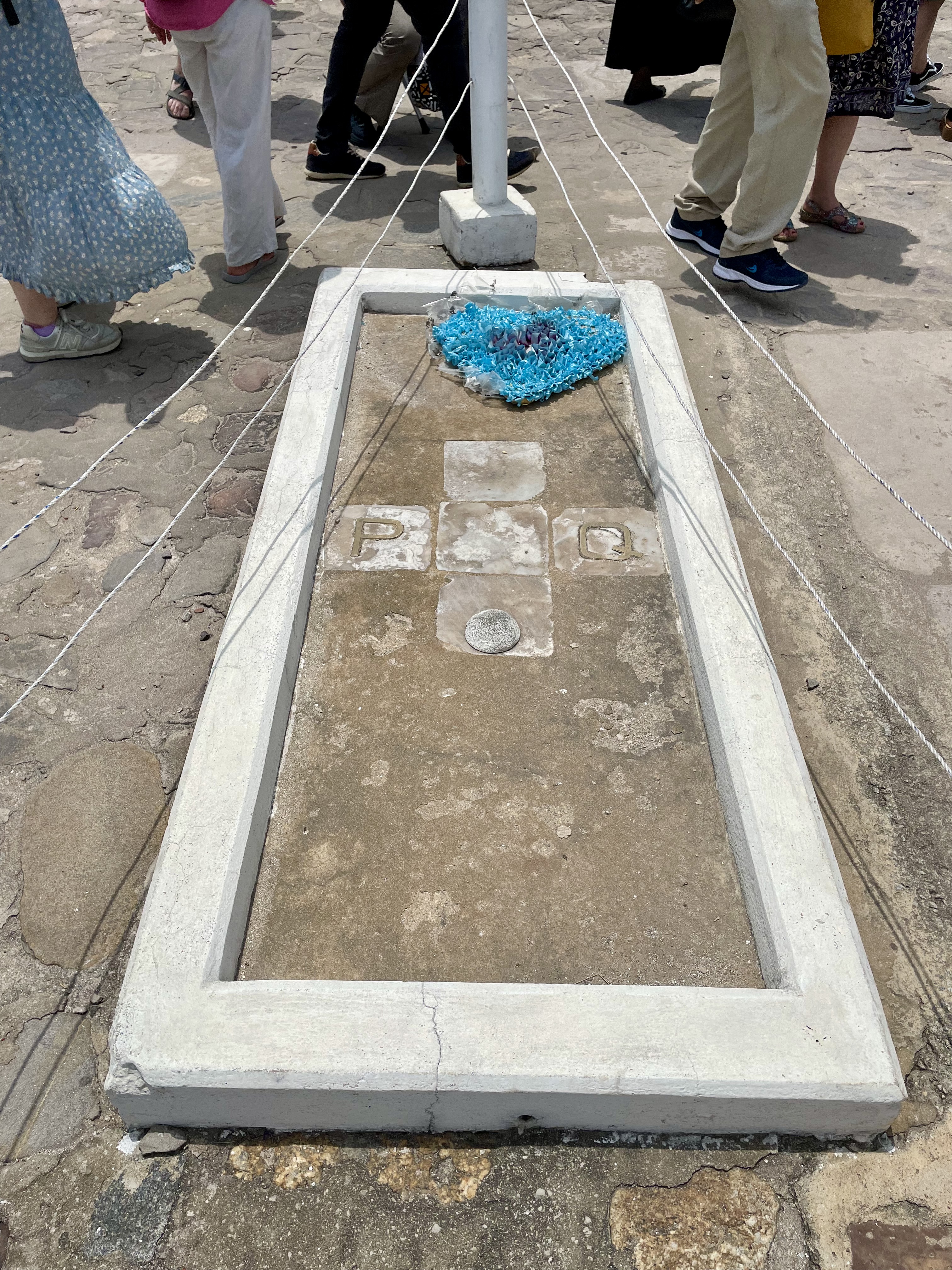
The grave of Rev. Philip Quaque (Photo by Author on 13. March 2024).
According to a curator of the castle museum, the following is a traditional ‘purification ceremony.’ On the ground of the courtyard, you will notice four white rectangular grave markers. The one that stands alone belongs to Quaque. (Video by the author on 13. March 2024).
As I already hinted, the castle faced multiple alterations and extensions over the years of its occupation by European powers. Indeed, after it was heavily bombarded by the French in the eighteenth century (during the Seven Years’ War), the heavily damaged structure was almost completely rebuilt. As a result of these and later alterations, one of the few ventilation shafts for the dungeon led to the floor of the structure that had been the worship space since at least 1766.
Whether as a byproduct of haphazard construction or by intention, according to one representative of the Ghana Museums & Monuments Board, “the opening in the floor of the chapel allowed the enslavers to keep a listening ear tuned toward the slaves beneath them while in there.”
Irony of tragic ironies, this seemingly innocuous hole, which I was not able to photograph due to ongoing restoration work, may also have allowed the enslaved people to listen to their enslavers as they sang hymns and prayed prayers to one of whom Paul of Tarsus said, “It is for freedom that Christ has set us free” (Gal. 5:1).
As my friend and colleague knew well, her fundamentally theological question about whose prayers God heard in such situations is not one that historians, even those who study the history of religions, can answer based on their field of competence. Later, she told me that she did not ask it because she was searching for an answer, be it historiographic, theological (both of us are also ordained ministers in Christian traditions), or otherwise.
Rather, by posing the question, she was giving voice to the startling cognitive dissonance we, like many before us, experience when we encounter such profound examples of the entanglements between slavery, colonialism, and the history of Christian mission.
The enduring legacies of these historic connections are on ready display in the modern cityscape surrounding the castle today. From the former Governor’s balcony of the castle, one can see the cathedrals of three of the historic denominations that traveled to Ghana via European colonial expansion and alongside the slave trade.
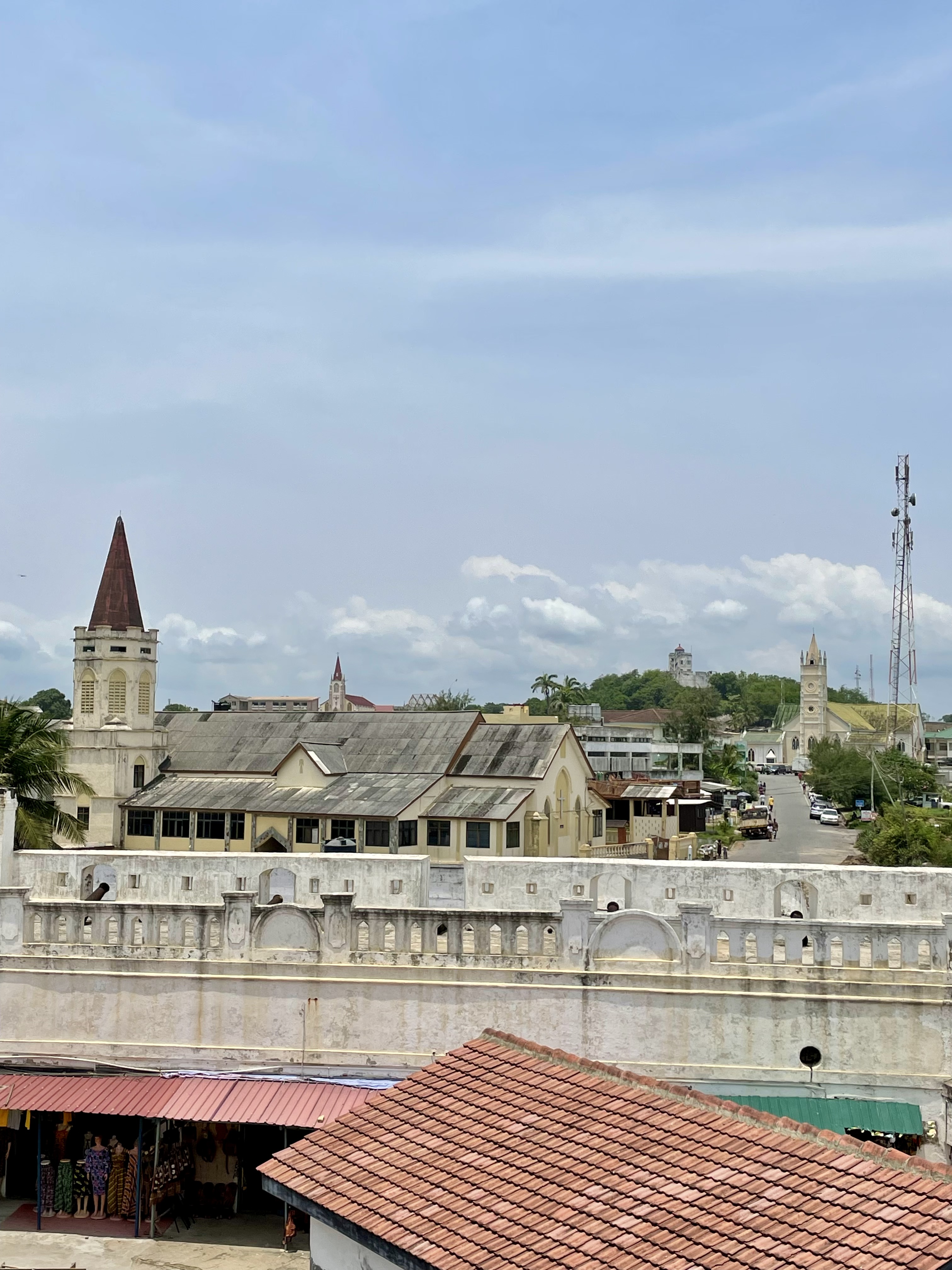
The closest church building is Christ Church Cathedral (Anglican). The white church with a green roof is the Wesley Methodist Cathedral, and the beige church with a red roof in the distance is St. Francis de Sales Roman Catholic Cathedral (Photo by the author on 13. March 2024).
Indeed, Cape Coast Castle is far from the only structure in Ghana that bears startling witness to the links between Christianity, empire, and slavery.
Just up the road from this site, in Elmina, one can visit the comparatively well-known Elmina Castle, which was erected by the Portuguese in 1482. At Elmina Castle, then known as Castelo de São Jorge da Mina, the Portuguese also established the first Roman Catholic Parish in West Africa. When the Dutch later took over the castle, they, too, set aside a space for worship. That space is thus perhaps the earliest Dutch Reformed church to be established in the region.
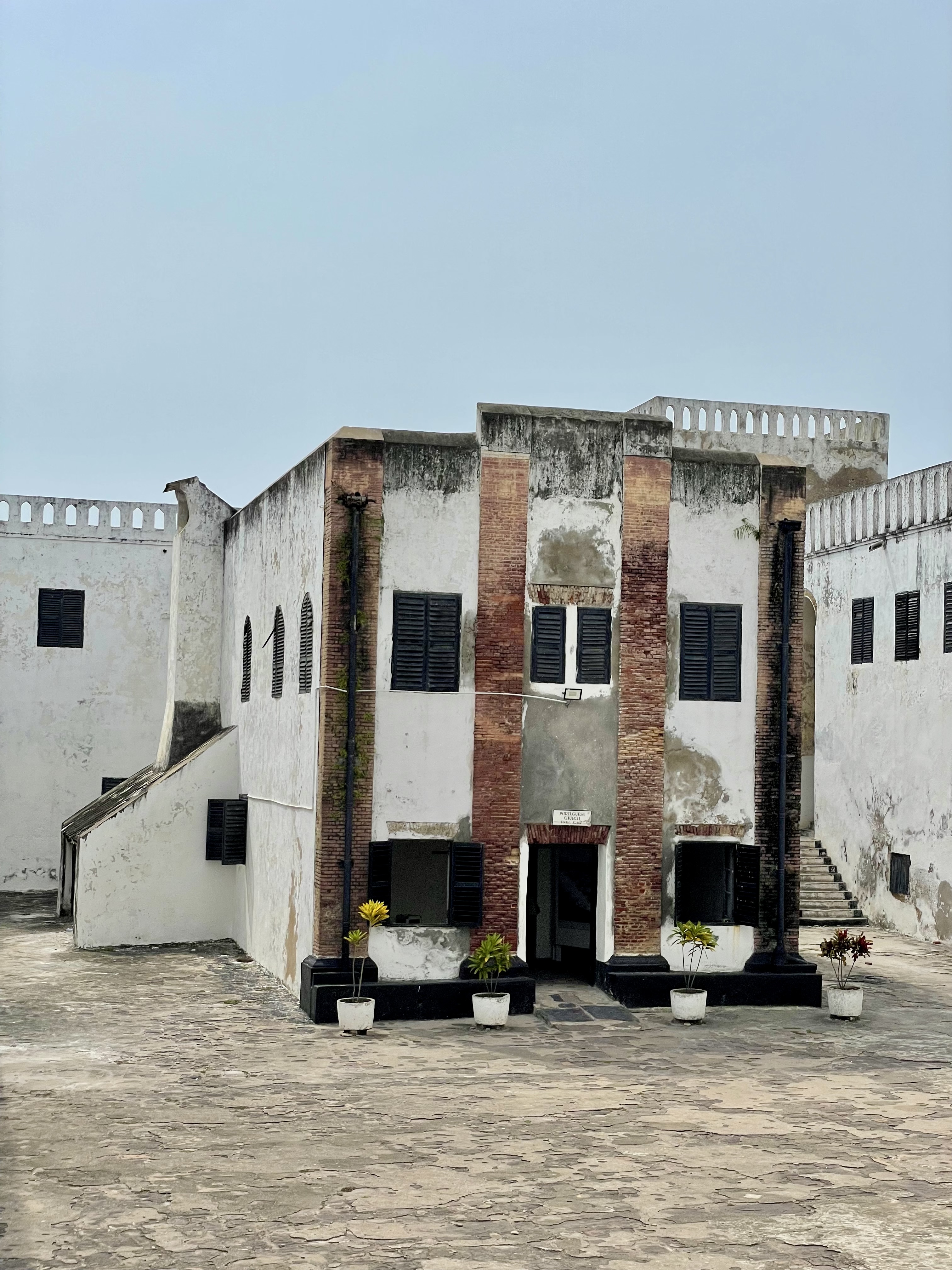
Here, we can see the ‘Portuguese Church,’ where Roman Catholic services were held until 1637, as it appears today. To the left (from the perspective of the photographer) was the ‘male slave dungeon,’ and to the right were two cells used to punish those who physically resisted enslavement (Photo by the author on 13. March 2024).
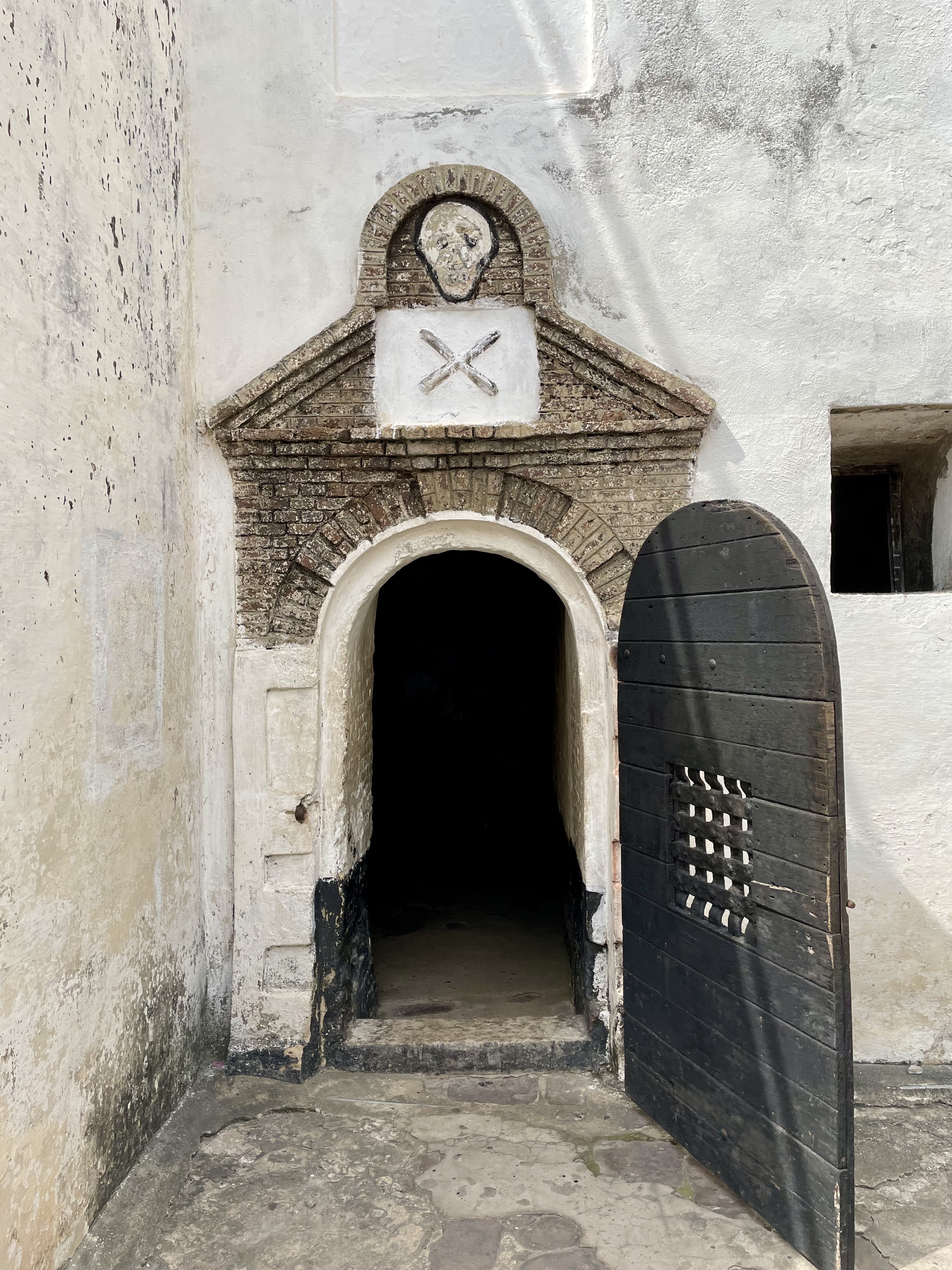
Unlike at Cape Coast Castle, the ‘door of no return’ at Elmina Castle, which opens onto the same courtyard as the main entrance of the Portuguese Church, was not the place from which enslaved people were loaded on ships for transport across the ocean. It was a torture chamber in which especially resistant enslaved people were placed until they died. This, the enslavers did as a deterrent for resistance by others (Photo by the author on 13. March 2024).
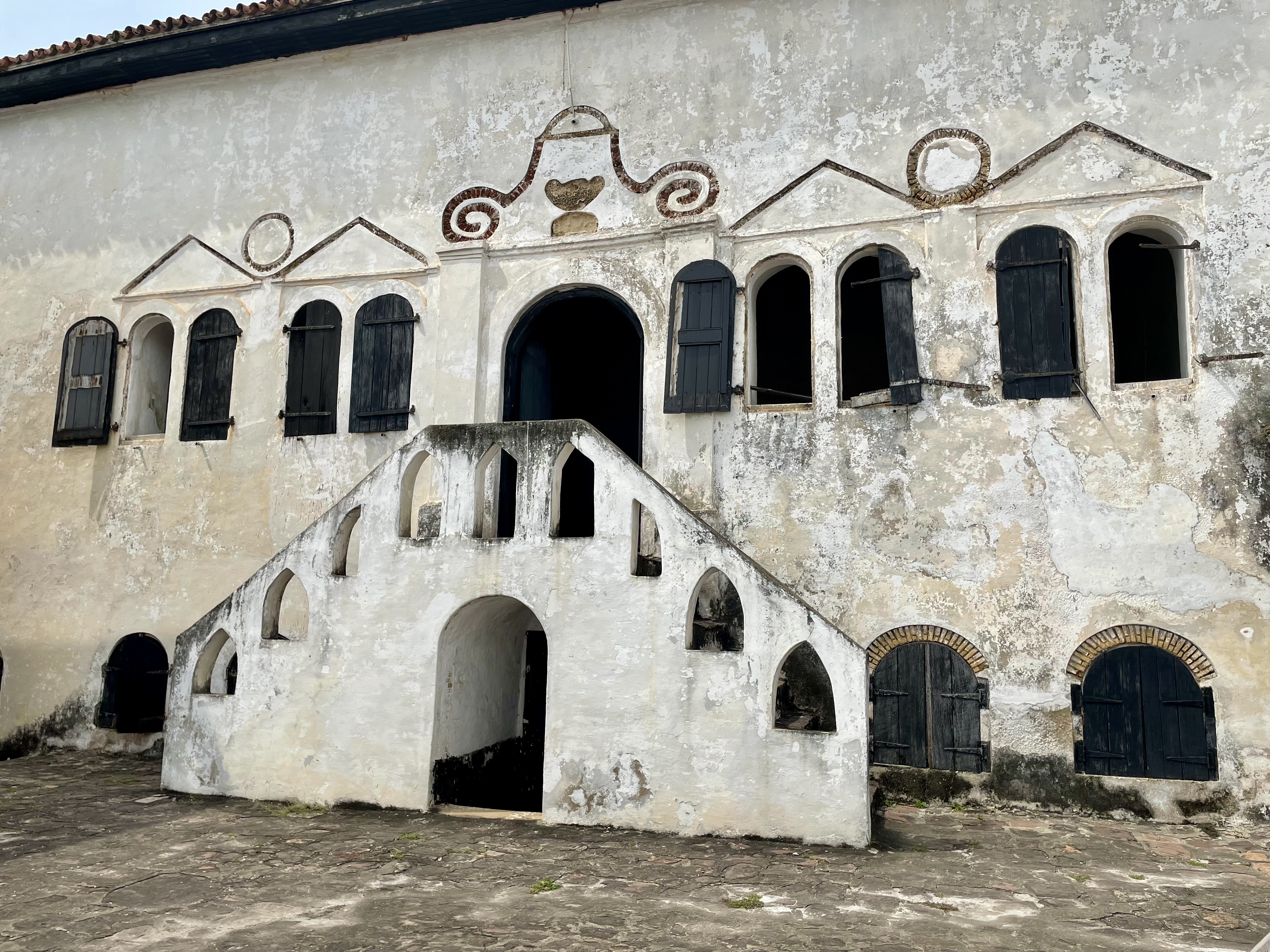
The ‘Dutch Church’ at Elmina, which stands atop a portion of the ‘female slave dungeon’ (Photo by the author on 13. March 2024).
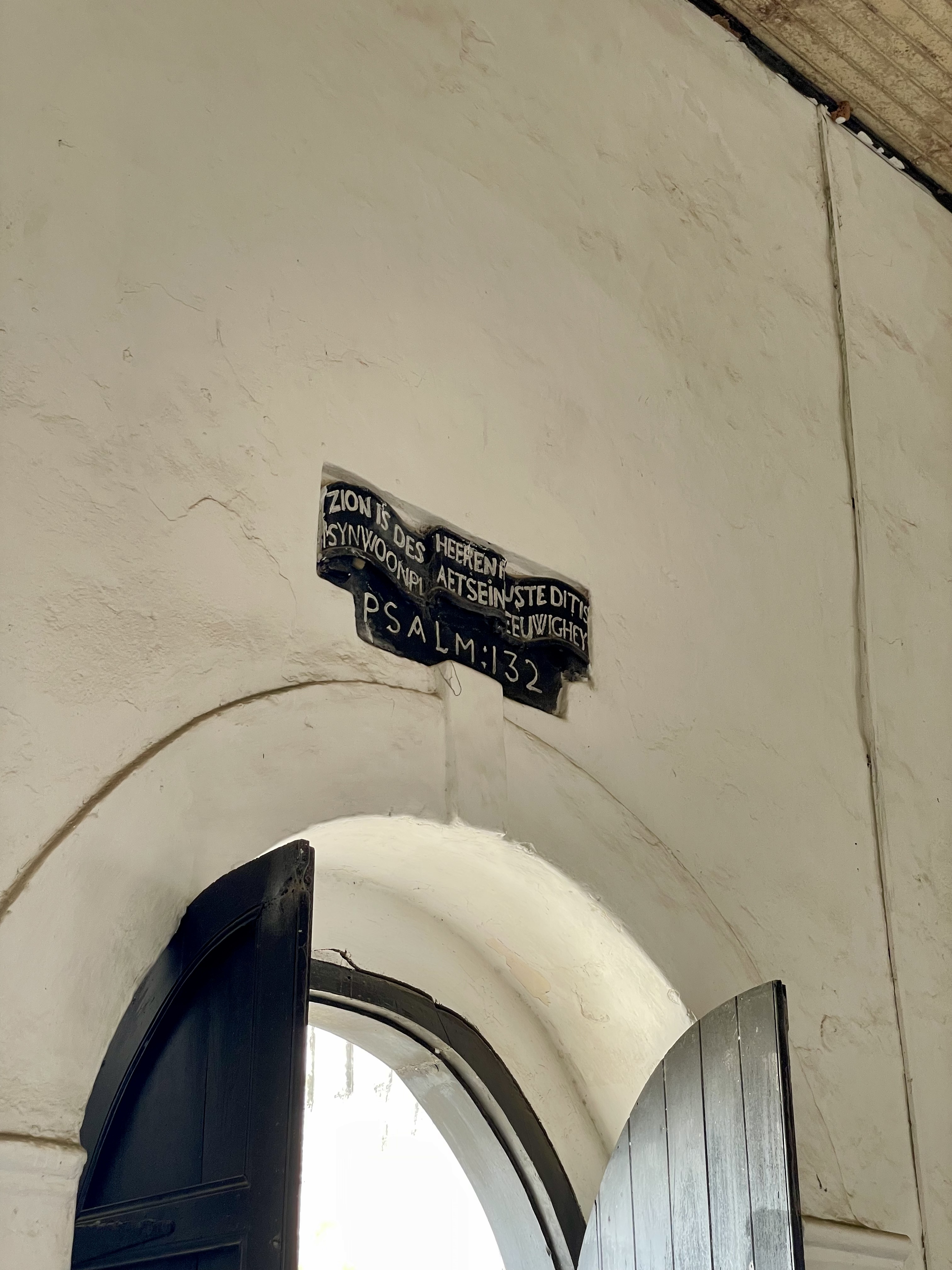
One of the few remaining design elements within the Dutch Church, this relief, which quotes Psalm 132:11 in Old Dutch, reads, “For the Lord has chosen Zion; he has desired it for his habitation. This is my resting place forever” (Photo by the author on 13. March 2024).
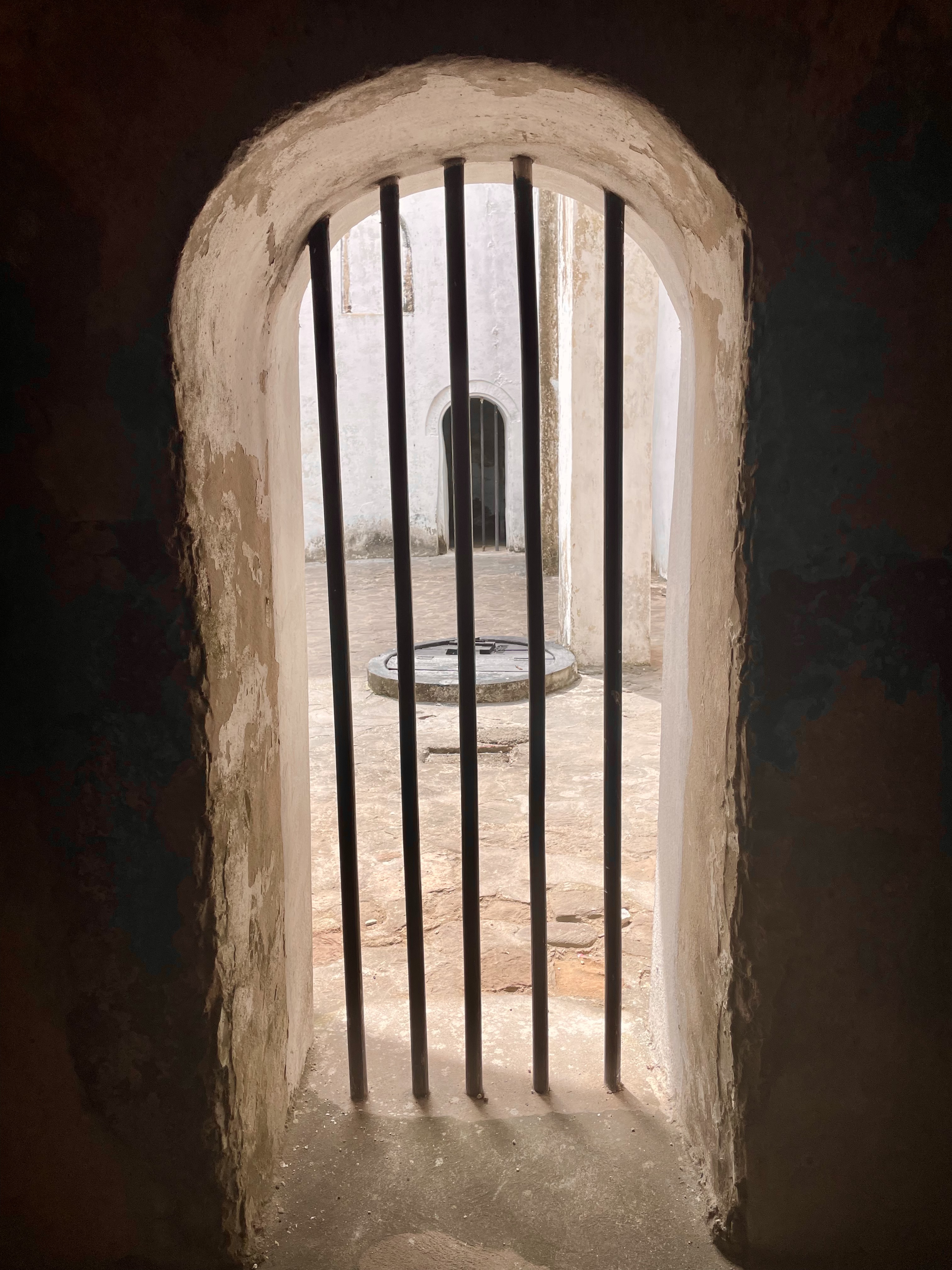
This view from a cell in which ‘female slaves’ dwelt looks out upon a small secondary courtyard that holds memories of abuse, assault, and torture. The Dutch church is located directly above it (Photo by the author on 13. March 2024).
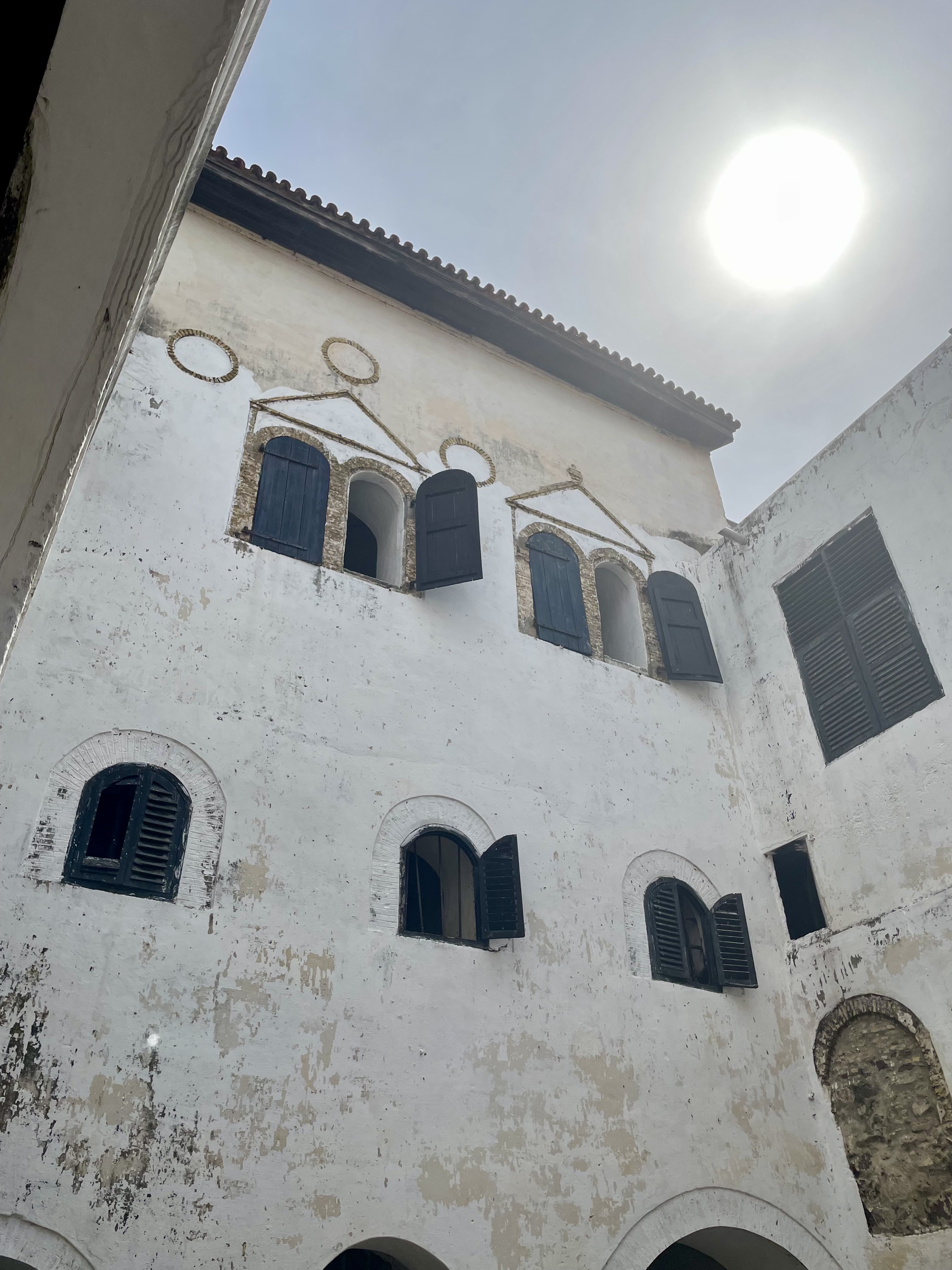
The decorated double windows at the top lead to the Dutch Church. Records show that women who resisted sexual exploitation by high-ranking colonial officials were chained to large iron balls and forced to remain in this courtyard under direct sunlight as punishment. This would have been their view of the church (Photo by the author on 13. March 2024).
After this lengthy excursion to the Cape Coast, it is worth explaining why my colleagues and I traveled to Ghana. We were there for the Fifth Annual World Christianity Conference, held from 11-15. March 2024. The conference, which is organized by Princeton Theological Seminary (PTS) and the Overseas Ministries Study Center (OMSC), was hosted by the Department for the Study of Religions at the University of Ghana (Legon).
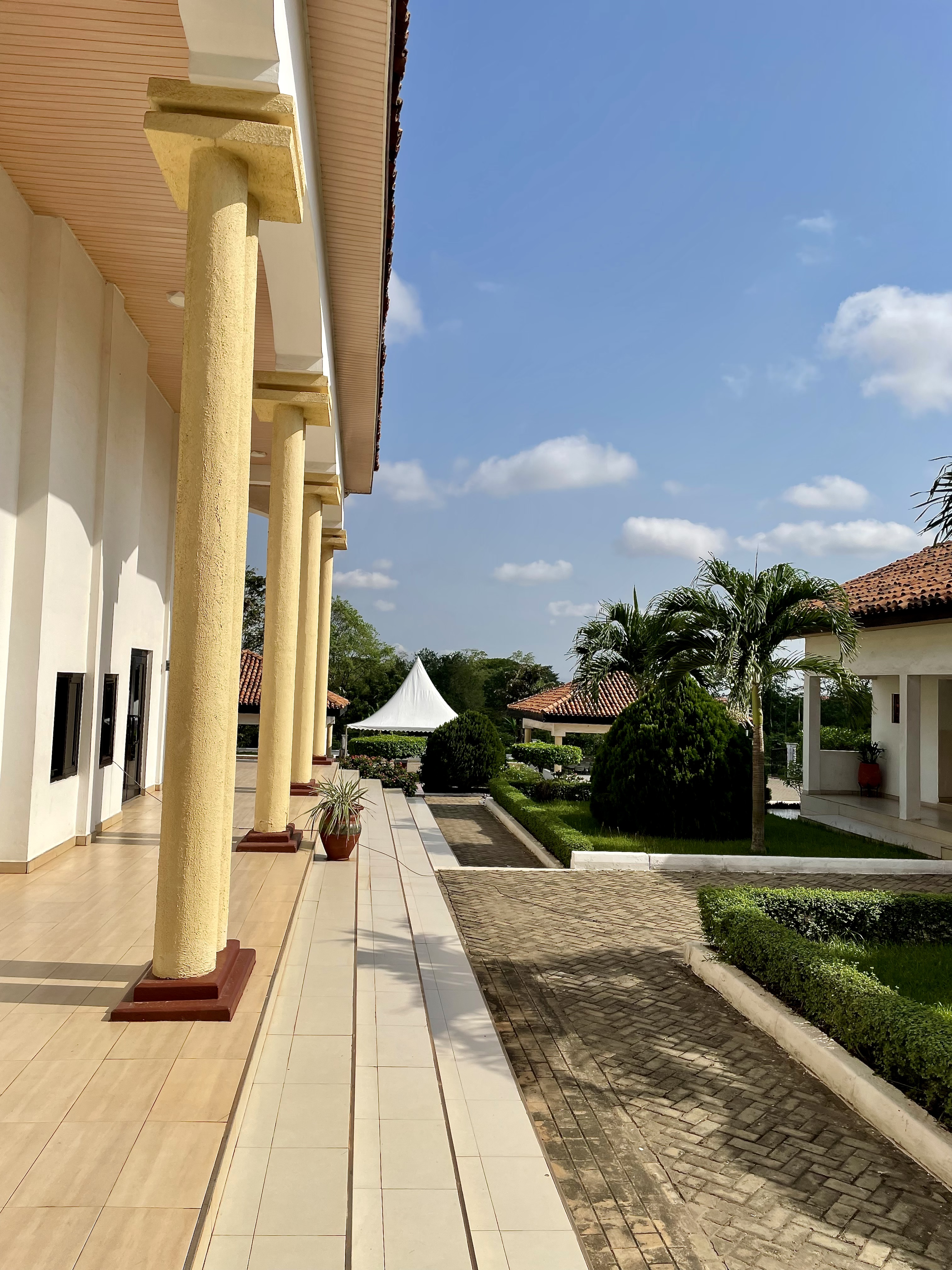
View from the portico of the plenary hall at the Institute of Statistical, Social and Economic Research at the University of Ghana, where the main sessions of the conference took place (Photo by author on 11. March 2024).
The PTS/OMSC World Christianity Conference has emerged as a premier global forum for world Christianity scholarship.
Though it has various definitions, the phrase ‘world Christianity’ or ‘world Christianity studies’ usually describes an “interdisciplinary approach to the academic study of Christianity as a worldwide, intercultural, contextually embodied, and historically shaped tradition” (Smith, WCSAD Concept Note). As an approach or framework for analysis, world Christianity calls for a paradigm shift in how Christianity is studied. The discourse thus fosters new “methodological, theoretical, and disciplinary perspectives that shed light on the diversity of Christianity(ies) over time, space, localities, and positionalities” (WCSAD Concept Note).
Since 2023, various members of the University of Bonn’s Faculty of Protestant Theology and the BCDSS have participated in the conference. In January 2024, several Cluster members and friends established the World Christianity Studies and Asymmetrical Dependency (WCSAD) Working Group to foster ongoing dialogue about the conceptual links between world Christianity as an approach and asymmetrical dependency as an analytical concept. From the start, we have also worked on shared projects with the organizers of the WC Conference.
The theme of this year’s conference was “Revisiting Women and Gender in World Christianity.”
In response to the ‘gender gap’ that pervades much of World Christianity scholarship, the conference invited papers that would explore questions like, to quote a few, How are emerging theologies, spaces, discourses, female bodies, agency, and polities increasingly gendered and negotiated within World Christianity? Which theoretical and methodological tools does the field offer to increase comprehension of ritual, political, economic, and social roles often associated with different cultural contexts worldwide, including diasporic communities? How is power gendered and negotiated in patrilocal and matrilocal sociocultural contexts and milieus within which global south and diaspora Christianities thrive today?
After the opening ceremony, the renowned Kwok Pui Lan, Dean’s Professor of Systematic Theology at Candler School of Theology of Emory University, gave the opening Gerald H. Anderson Lecture. Her talk, which was primarily historiographic, spanned various contexts. It explored themes related to gender in mapping Christianity’s history in China, to the involvement of churches and theologians in healthcare advocacy around HIV and AIDS in the 1980s and 1990s, to the recent ‘theologizations’ around what she called the “feminization of migration.”
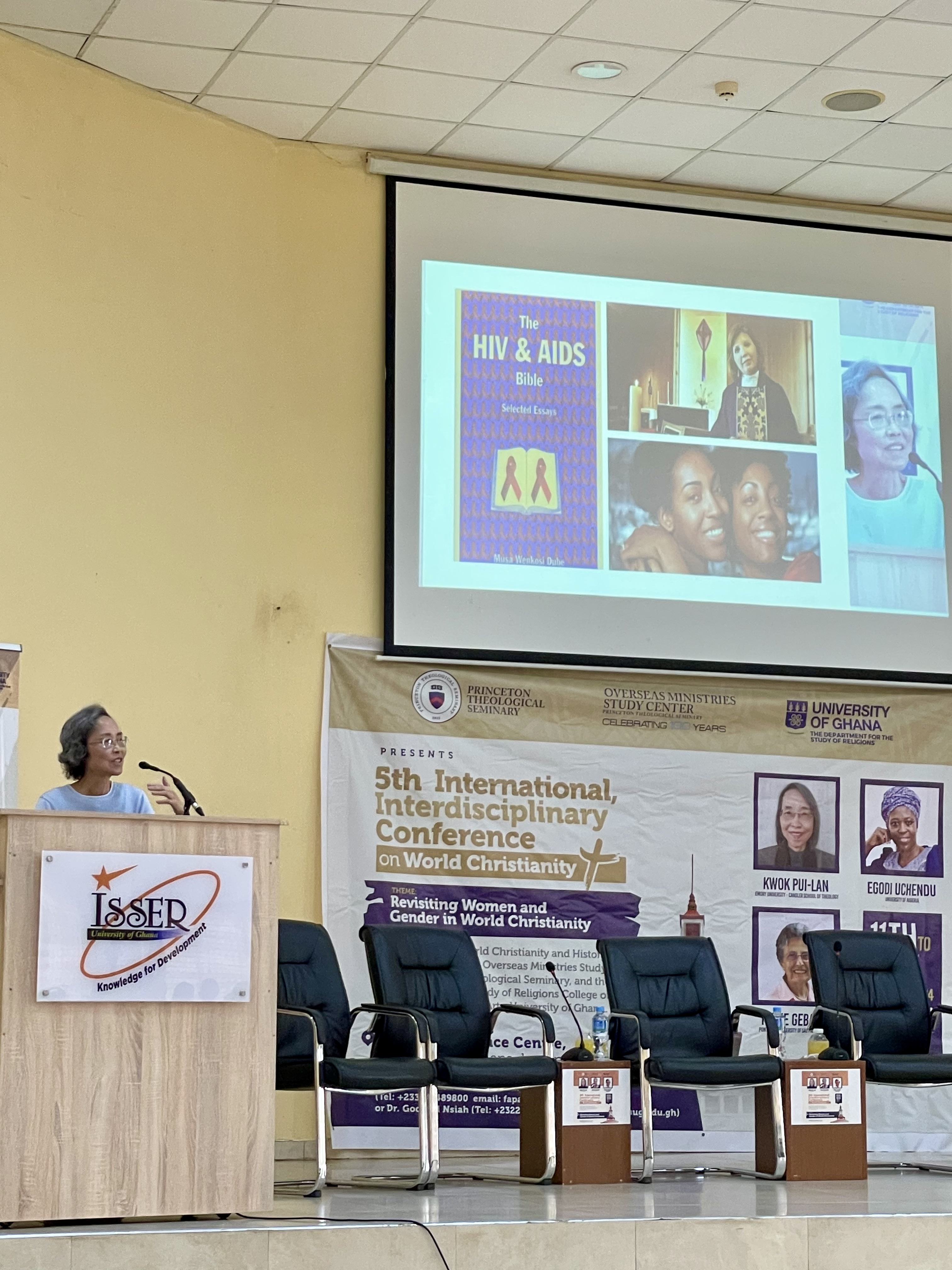
Prof. Dr. Kwok Pui-Lan, one of the world’s leading constructive theologians, delivers her lecture at the 2024 WC Conference (Photo by the author on 11. March 2024).
The paper sessions explored a diverse array of topics. While many scholars presented on matters related to Ghana and West Africa, the regional and temporal foci of the presentations spanned the gamut.
Diverse presentations also evidenced what I would consider the ‘big three’ trajectories in world Christianity scholarship: 1) history of Christianity(ies), 2) social science analysis of Christianities, and 3) constructive theological reflection that centers the perspectives, approaches, and insights of studies in world Christianity.
The first two approaches are primarily empirical, with the third being axiological. Of course, we should also note that a prominent characteristic of world Christianity scholarship, at the WC Conference and elsewhere, is a conscious ‘blurring of the lines’ between these approaches. Thus, for many conference attendees, they are not mutually exclusive categories.
Dr. Gina Zurlo, Yang Visiting Scholar of World Christianity at Harvard Divinity School and Co-Director of the Center for the Study of Global Christianity at Gordon-Conwell Theological Seminary, dropped a bombshell in her plenary lecture. Dr. Zurlo presented portions of her groundbreaking book ‘Women in World Christianity: Building and Sustaining a Global Movement’ (2023). This sociological and demographic work provides “the first quantitative dataset on gender in every Christian denomination in every country of the world.” The results of this study are truly stunning.
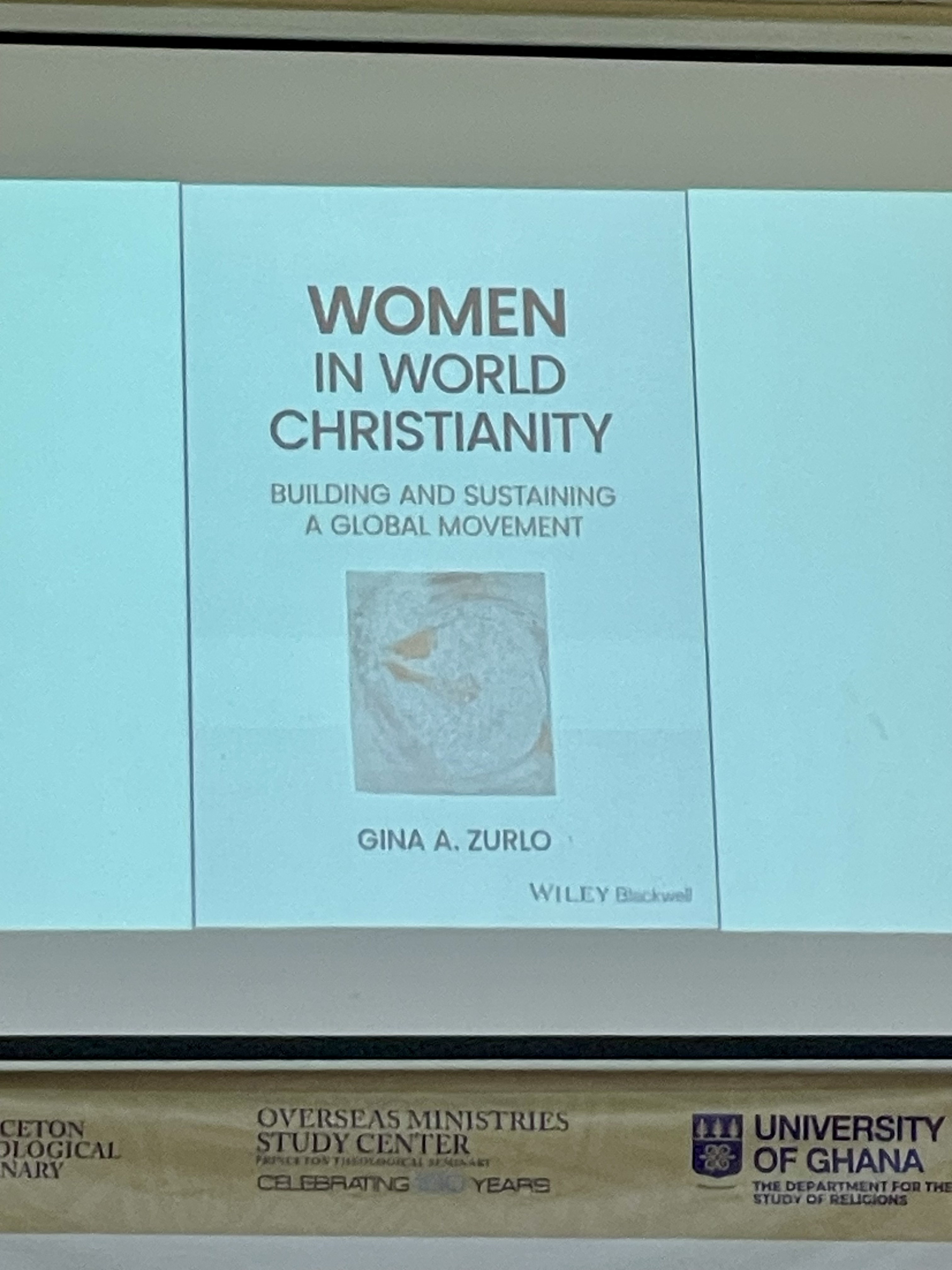
Photo taken during the presentation (Photo by author on 11. March 2024).
The Women in World Christianity Project is upending more than a few preconceptions about the formative impact and self-empowerment of women within the world Church.
The conference also held a plenary in honor of Mercy Amba Ewudziwa Oduyoye, a Ghanaian Methodist theologian, ecumenist, poet, and director of the Institute of African Women in Religion and Culture at Trinity Theological Seminary in Legon. In 1989, she was among the founders of the Circle of Concerned African Women Theologians, which continues to shape ecumenical theological discourse around the world.
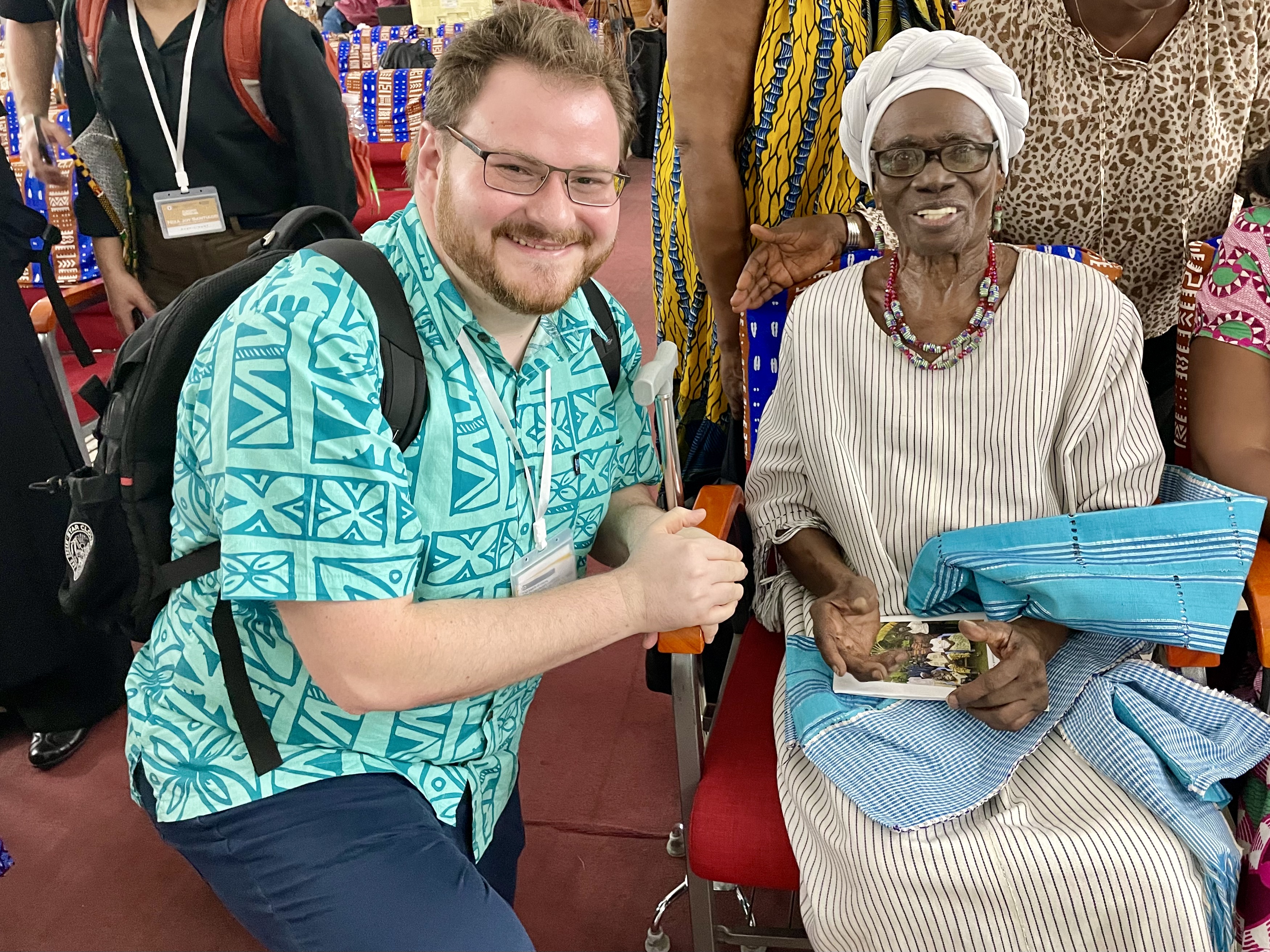
I had the pleasure of meeting Oduyoye, whose work I first encountered as an undergraduate student of religion and philosophy many years ago (Photo by the author on 14. March 2024).
As I reflect on my all-too-brief experience in Ghana, a few impressions stand out. Regarding the conference, I cannot help but applaud the organizers and hosts for their successful attempt to ‘put their money where their mouth is’ when it comes to creating spaces where historically marginal voices within the churches and world Christianity scholarship can be heard.
For the first four years after its establishment, the conference was held in Princeton. The 2024 conference marked the first attempt to host the event outside of North America. Moving forward, the conference organizers plan to rotate between ‘home base’ and elsewhere. Next year, the conference will be in Princeton, and after that, somewhere else, and so on.
As I was one of the few scholars who presented on a theme related to gender and sexuality, I was also left with another impression. I am keenly aware of how much farther we must go (both academically and in terms of the inclusion of silenced voices) before world Christianity discourses can engage constructively with intercultural questions around sexual orientation, gender identity, and sex characteristics.
Robust academic and theologically liberative discussions around the diversity of gender and sexuality in human experience are alive and well in many (unexpected!) places in the world Church, but, in general, our scholarship has yet to reflect this grassroots reality. What a loss that is!
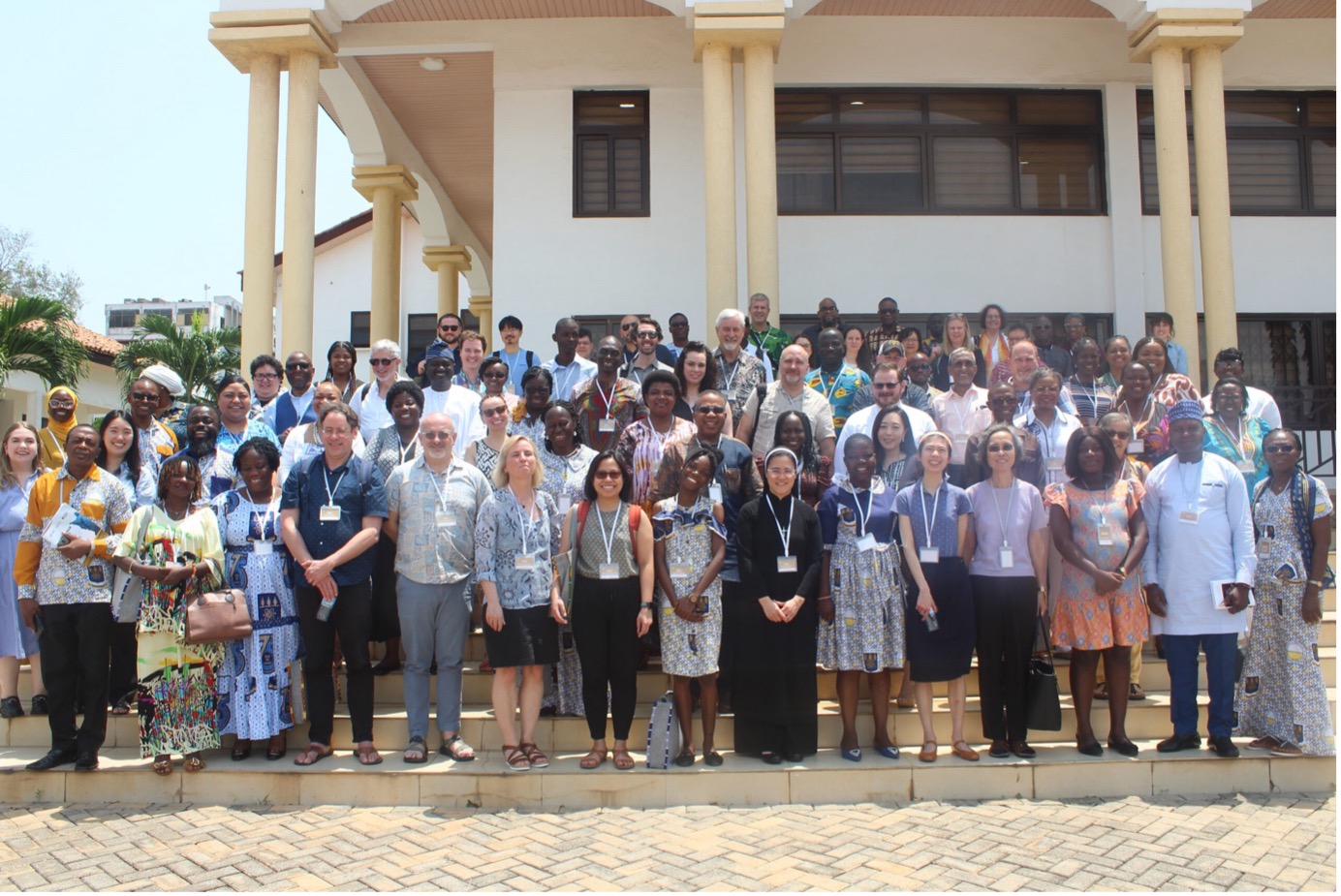
One of many group photos taken at the conference (Photo credit: Princeton Theological Seminary)
In the future, world Christianity scholarship and conferences dedicated to strengthening the field should also create more space for engagement on questions related to the history and enduring legacies of slavery and other forms of strong asymmetrical dependency.
As we traveled between the Elmina and Cape Coast castles, several Ghanaian members of our group shared that they grew up hearing things like, “Yes, what happened was really horrible [i.e., the enslavement of millions of people], but at least we got the gospel out of it all.” For many of the brilliant young scholars of religion I encountered at the 2024 WC Conference, this summary of Christian history in places like Ghana no longer satisfies. Indeed, it has never been truly satisfying.
According to one PhD Researcher at the conference, “It is time for the Church and the churches to atone; to tell the stories (some good, some bad, all messy) of the church and slavery, and abolition and all that.” Within World Christianity discourses, therefore, it is time to devote more energy to the consideration of slaveries and dependencies past and present. Our field could emerge as an epicenter of reflection on the role of the church in supporting, subverting, combatting, and collaborating with the institutions and people who engaged (and continue to engage!) in practices that undermine human dignity. In this endeavor, we can also help uncover or retell stories of resistance and resilience within and beyond this global faith tradition we scrutinize and, in many cases, embrace.
Scholars in our field could provide invaluable contributions to the process of mapping the topography of slavery and asymmetrical dependencies across time and space.
Many of the projects that could emerge from such an endeavor would undoubtedly leave the question, ‘whose prayers did God hear?’ – those of the enslavers in plastered churches or the enslaved in bare stone dungeons – to the constructive theologians in the field. Yet, most would probably acknowledge that existential questions like this echo through the waves of history, are woven into the threads of societies past and present, and endure in concrete experiences of what, to quote Burns, who used the gendered language of his time, we may call ‘Man’s inhumanity to man.’
Subscribe to my newsletter
Read articles from David Smith directly inside your inbox. Subscribe to the newsletter, and don't miss out.
Written by
